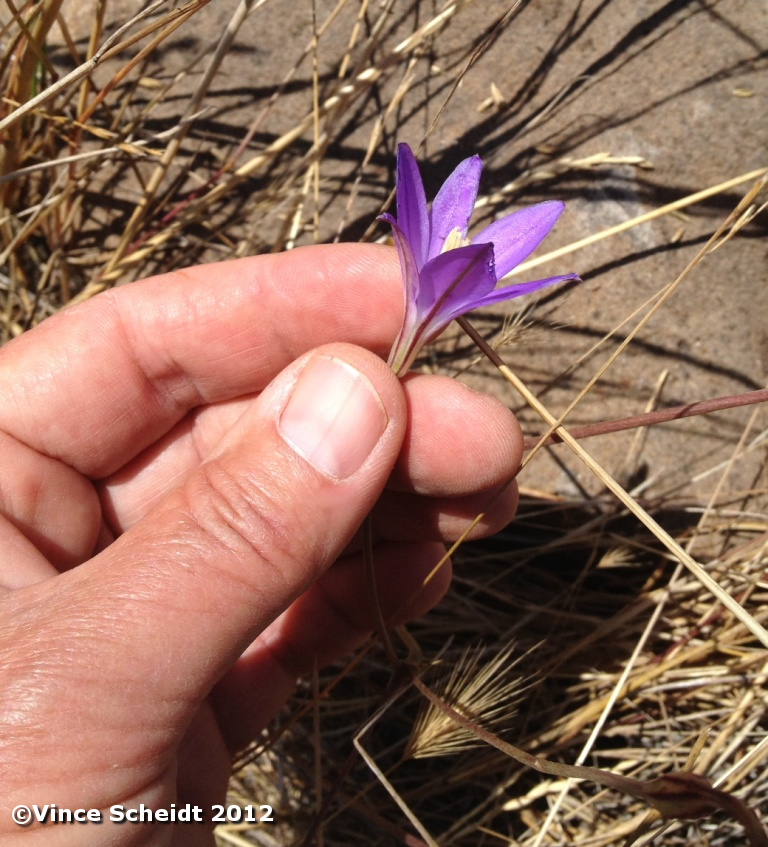
Santa Rosa Basalt Brodiaea
Brodiaea santarosae
Brodiaea santarosae
Goal: Maintain existing Santa Rosa brodiaea occurrences to ensure multiple conserved occurrences with self sustaining populations to increase resilience to environmental and demographic stochasticity, maintain genetic diversity, and improve chances of persistence over the long term (>100 years) in grassland and vernal pool/alkali playa habitats.
Management units: 8
In 2018, inspect extant Santa Rosa brodiaea occurrences on Conserved Lands (see occurrence table) using the regional rare plant IMG monitoring protocol to record abundance and collect habitat and threats covariate data to determine management needs.
| Action | Statement | Action status | Projects |
|---|---|---|---|
| IMP-1 | Based upon occurrence status and threats, determine management needs including whether routine management or more intensive management is warranted. | on hold | |
| IMP-2 | Submit project metadata, monitoring datasets and management recommendations to the MSP Web Portal. | on hold |
| Criteria | Deadline year |
|---|---|
| Surveys Completed in 2018 with Management Recommendations | 2021 |
| Threat Name | Threat Code |
|---|---|
| Human uses of the Preserves | HUMUSE |
| Invasive plants | INVPLA |
Management units: 8
Beginning in 2019, conduct routine management actions as identified through the IMG monitoring in 2018 at Santa Rosa brodiaea occurrences on Conserved Lands (see occurrence table). Depending on the type and level of threat, management should be conducted as needed, not necessarily every year, and using BMPs with precautions to do no harm.
| Action | Statement | Action status | Projects |
|---|---|---|---|
| IMP-1 | Perform as needed routine management activities, such as protecting occurrences from disturbance through fencing and enforcement and controlling invasive non-native plant species =20% absolute cover. | on hold | |
| IMP-2 | Submit project metadata and management data to the MSP Web Portal. | on hold |
| Criteria | Deadline year |
|---|---|
| Routine Management Completed as Needed Based Upon Monitoring Recommendations | 2021 |
| Threat Name | Threat Code |
|---|---|
| Human uses of the Preserves | HUMUSE |
| Invasive plants | INVPLA |
| File name | Lead Author | Year | Type |
|---|---|---|---|
| Management Strategic Plan (MSP) 2015 Monitoring Protocol for Rare Plant Occurrences on Conserved Lands in Western San Diego County | San Diego Management and Monitoring Program | 2015 | report |
Southwest Riverside County and immediately adjacent Miller Mountain in San Diego County [1]. Smallest range of the southern California Brodiaeas, with just four known populations occupying only a small portion of a 40 km2 area, plus a fifth small population disjunct by 11 km.
Three occurrences on Conserved Lands in MU8 (Cleveland National Forest).
None [2].
Occurs only on or very close to the 8–11 million-year-old Santa Rosa Basalt [1]. Grows in many habitats, including next to vernal pools, but can also grow in drier locations. Can grow in disturbed areas, disturbed soils, on top of the water pipes, and in roadside berms. Elevation range 565-1045 meters [2].
New species of Brodiaea previously collected by at least six different botanists and variously determined as B. orcuttii (E. Greene) Baker, B. filifolia (S. Watson), or a hybrid between the two [1]. Analysis distinguished it from B. filifolia and B. orcuttii by at least 11 separate characteristics. In the Themidaceae family [2].
Perennial bulbiferous herb [2] and basalt endemic [1].
Blooming period is May-June [2]. Seeds mature in late spring and early summer.
Often reproduce by corms with populations in small areas often being clonal [1].
There appears to be low threat from humans [1] with possible threats from development [2]. Long-term threat is the erosion of the Santa Rosa Basalt and loss of native habitat [1]. Forms sterile hybrids with B. terrestris ssp. kernensis [2].
Appears to exist stably with the abundant nonnative grasses that are found at a few of the sites [1]. Four of the known populations are protected as part of the Santa Rosa Plateau Ecological Reserve and Cleveland National Forest. The large population on Avenaloca Mesa is partially protected by the Nature Conservancy.
[1] Chester, T., W. Armstrong, and K. Madore. 2007. “Brodiaea Santarosae (Themidaceae), a New Rare Species from the Santa Rosa Basalt Area of the Santa Ana Mountains of Southern California.†Madrono 54 (2): 187–98. doi:10.3120/0024-9637(2007)54[187:bstanr]2.0.co;2.
[2] CNPS, Rare Plant Program. 2016. Inventory of Rare and Endangered Plants (online edition, v8-02). California Native Plant Society, Sacramento, CA. http://www.rareplants.cnps.org, accessed 30 August 2016.